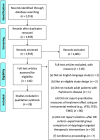Effectiveness of Interventions for Dysphagia in Parkinson Disease: A Systematic Review
- PMID: 34890260
- PMCID: PMC9159671
- DOI: 10.1044/2021_AJSLP-21-00145
Effectiveness of Interventions for Dysphagia in Parkinson Disease: A Systematic Review
Abstract
Purpose: Dysphagia is a common sequela of Parkinson disease (PD) and is associated with malnutrition, aspiration pneumonia, and mortality. This review article synthesized evidence regarding the effectiveness of interventions for dysphagia in PD.
Method: Electronic searches were conducted in Ovid MEDLINE, Embase, Cochrane Central Register of Controlled Trials, CINAHL, and speechBITE. Of the 2,015 articles identified, 26 met eligibility criteria: interventional or observational studies with at least five or more participants evaluating dysphagia interventions in adults with PD-related dysphagia, with outcomes measured using videofluoroscopic swallowing study (VFSS), fiberoptic endoscopic evaluation of swallowing (FEES), or electromyography (EMG). Risk of bias (RoB) was evaluated using the Evidence Project tool and predetermined criteria regarding the rigor of swallowing outcome measures.
Results: Interventions were classified as follows: pharmacological (n = 11), neurostimulation (n = 8), and behavioral (n = 7). Primary outcome measures varied across studies, including swallowing timing, safety, and efficiency, and were measured using VFSS (n = 17), FEES (n = 6), and EMG (n = 4). Critical appraisal of study findings for RoB, methodological rigor, and transparency showed the majority of studies failed to adequately describe contrast media used, signal acquisition settings, and rater blinding to time point. Low certainty evidence generally suggested improved swallow timing with exercises with biofeedback and deep brain stimulation (DBS), improved safety with DBS and expiratory muscle strength training, and improved efficiency with the Lee Silverman Voice Treatment and levodopa.
Conclusions: Studies with lower RoB and greater experimental rigor showed potential benefit in improving swallowing efficiency but not safety. Further research investigating discrete changes in swallowing pathophysiology post-intervention is warranted to guide dysphagia management in PD.
Supplemental material: https://doi.org/10.23641/asha.17132162.
Figures


References
-
- Alfonsi, E. , Restivo, D. A. , Cosentino, G. , De Icco, R. , Bertino, G. , Schindler, A. , Todisco, M. , Fresia, M. , Cortese, A. , Prunetti, P. , Ramusino, M. C. , Moglia, A. , Sandrini, G. , & Tassorelli, C. (2017). Botulinum toxin is effective in the management of neurogenic dysphagia. Clinical-electrophysiological findings and tips on safety in different neurological disorders. Frontiers in Pharmacology, 8, 80. https://doi.org/10.3389/fphar.2017.00080 - PMC - PubMed
-
- Andersson, I. , & Sidenvall, B. (2001). Case studies of food shopping, cooking and eating habits in older women with Parkinson's disease. Journal of Advanced Nursing, 35(1), 69–78. https://doi.org/10.1046/j.1365-2648.2001.01823.x - PubMed
-
- Argolo, N. , Sampaio, M. , Pinho, P. , Melo, A. , & Nóbrega, A. C. (2013). Do swallowing exercises improve swallowing dynamic and quality of life in Parkinson's disease? NeuroRehabilitation, 32(4), 949–955. https://doi.org/10.3233/NRE-130918 - PubMed
-
- Ashford, J. , McCabe, D. , Wheeler-Hegland, K. , Frymark, T. , Mullen, R. , Musson, N. , Schooling, T. , & Hammond, C. S. (2009). Evidence-based systematic review: Oropharyngeal dysphagia behavioral treatments. Part III—Impact of dysphagia treatments on populations with neurological disorders. Journal of Rehabilitation Research & Development, 46(2), 222–215. https://doi.org/10.1682/JRRD.2008.08.0093 - PubMed
-
- Athukorala, R. P. , Jones, R. D. , Sella, O. , & Huckabee, M. L. (2014). Skill training for swallowing rehabilitation in patients with Parkinson's disease. Archives of Physical Medicine and Rehabilitation, 95(7), 1374–1382. https://doi.org/10.1016/j.apmr.2014.03.001 - PubMed
Publication types
MeSH terms
Grants and funding
LinkOut - more resources
Full Text Sources
Medical
Miscellaneous

